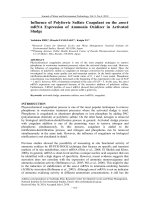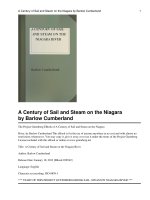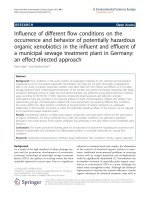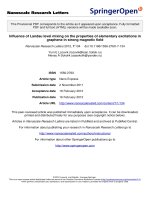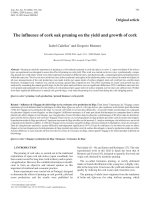Influence of Confined Acoustic Phonons on the Nonlinear Acousto-electric Effect in Doped Semiconductor Superlattices
Bạn đang xem bản rút gọn của tài liệu. Xem và tải ngay bản đầy đủ của tài liệu tại đây (817.83 KB, 8 trang )
<span class='text_page_counter'>(1)</span><div class='page_container' data-page=1>
74
Original Article
Influence of Confined Acoustic Phonons on the Nonlinear
Acousto-electric Effect in Doped Semiconductor Superlattices
Nguyen Quyet Thang
*<sub>, Nguyen Dinh Nam, Nguyen Quang Bau </sub>
<i>Faculty of Physics, VNU University of Science, 334 Nguyen Trai, Hanoi, Vietnam </i>
Received 23 March 2019
<i>Accepted 18 April 2019 </i>
<b>Abstract: By using a quantum kinetic equation for electrons, we have studied the Acousto-electric </b>
effects in doped semiconductor superlattice (DSSL) under the influence of confined phonon.
Considering the case of the electron - acoustic phonon interaction, we have found the expressions
of the nonlinear quantum acousto-electric current. From these expression, the acousto-electric
current (AEC) depends nonlinearly on temperature, acoustic wave frequency and the characteristic
parameters of DSSL (For example: the doped concentration <i>n<sub>D</sub></i>). Moreover, the expression of the
AEC under the influence of confined phonons fairly different from the case of unconfined phonons.
The results are numerically calculated for the GaAs:Be/ GaAs:Si DSSL; therefore, it can be easily
seen that the dependence of the acousto-electric current on the characteristic parameters of the
<i>acoustic wave, temperature, the characteristic parameters of DSSL and the quantum number m </i>
characterizing the phonons confinement. The results have showed that the appearance of phonons
confinement make the AEC value changes remarkably. The AEC is almost stable in low acoustic
wave frequency condition and changes as a parabolic curve when 𝜔𝑞 move up. On the other hand,
in case of low doped concentration number the AEC surges as a parabolic function in the dependence
on 𝑛𝐷, then it remains stability at just below zero in high 𝑛𝐷 value.
<i>Keywords: Acousto-electric field, Quantum kinetic equation, Doped superlattices, Electron - phonon </i>
interaction.
<b>1. Introduction</b>
In recent years, the semiconductor materials have been widely used in electronics. The development
of semiconductor electronics is mainly based on the phenomenon of contact p-n and the doped ability
________
<sub>Corresponding author. </sub>
<i> Email address: </i>
</div>
<span class='text_page_counter'>(2)</span><div class='page_container' data-page=2>
to alter the physical properties of crystals. Consequently, the acousto-electric effects in bulk materials
and mesoscopic structures has become interests of many scientists [1-8]. In recent time, the
acousto-electric effect was studied in both one-dimensional system [9] and finite-length ballistic channel
[10-11]. In addition, the acousto-electric effect was measured by an experiment in a submicron-seperated
quantum wire [12], in a carbon nanotube [13] and was also studied in the infinite potential cylindrical
wire [14]. However, these studies only considered the electrons - unconfined phonons interaction while
recent works show the vital contribution of phonons confinement in these kinetic properties [15]. So, in
this work, we study the influence of confined acoustic phonons on the nonlinear acousto-electric effect
in a DSSL
In literature, there are some methods to solve this problem such as: the Kubo-Mori method, the
Boltzmann kinetic equation. However, the limitation of both the Kubo-Mori method and the Boltzmann
equation are used in high temperature conditions only. In order to eliminate this limitation and to have
more accurate results, we have used a quantum kinetic equation for electrons to study the
acousto-electric effect in doped superlattice under the influence of confined phonons.
We have discovered some differences between the results obtained in this case and those in the case
of unconfined phonons. Numerical calculations are carried out with a specifically doped superlattice
GaAs:Be/ GaAs:Si.
<b>2. Calculation of acousto-electric current in doped semiconductor superlattice A </b>
In this report, we consider a simple model of a DSSL (n-i-p-i superlattice) in which electron gas is
confined by an additional potential along the z-direction and free in the (x-y) plane. The DSSL is
subjected to a crossed electric field <i>E</i>( , 0, 0)<i>E</i> , magnetic field <i>B</i>(0, 0, )<i>B</i> .
𝜓𝑛,𝑝⃗(𝑟⃗) = 𝑒𝑖𝑝⃗⊥𝑟⃗⊥𝑈𝑛(𝑟⃗) ∑ 𝑒𝑖𝑝𝑧𝑚𝑑𝜓𝑛(𝑧 − 𝑚𝑑)
𝑁<sub>𝑑</sub>
𝑚=1
𝜀𝑛(𝑝⃗⊥) =
ℏ2𝑝⃗⊥2
2𝑚∗ + ℏ𝜔𝑝(𝑛 +
1
2)
Here: 𝑛 = 0,1,2, … is the quantum number of the energy spectrum in z-direction,
𝑈𝑛(𝑟⃗) is the matrix operator form of 𝑈 = exp(𝑖𝑔𝑦− 𝑘𝑒𝑧) ; 𝑘𝑒= (𝑞2− 𝜔𝑞2⁄𝐶𝑒2)
1/2
, 𝑚∗<sub> is the electron </sub>
effective mass, 𝑑 is the superlattices period length and 𝑁𝑑 is superlattices period number. 𝑝⃗ = (𝑝⃗⊥, 𝑝⃗𝑧)
is the electron momentum vector. And 𝜔𝑝 is the plasma frequency characterizing for the DSSL
confinement in the z-direction, given by 𝜔𝑝= (
4𝜋𝑒2𝑛𝑝
𝑋0𝑚∗ )
2
, where 𝑋0 is the electronic constant (vacuum
permittivity),
The Hamiltonian of the electron-acoustic phonon system in DSSL in the second quantization
presentation can be written as:
𝐻 = ∑ 𝜀𝑛′(𝑝⃗<sub>⊥</sub>, )𝑎<sub>𝑛</sub>′<sub>,𝑝⃗</sub>
⊥
,
+ <sub>𝑎</sub>
𝑛′<sub>,𝑝⃗</sub>
⊥
,
𝑛′<sub>,𝑝⃗</sub>
⊥
, + ∑ ħ𝜔<sub>𝑚,𝑞⃗⃗</sub>
⊥𝑏𝑚,𝑞⃗⃗⊥
+ <sub>𝑏</sub>
𝑚,𝑞⃗⃗⊥
𝑚,𝑞⃗⃗⊥ +
∑ 𝐶<sub>𝑘</sub>⃗⃗𝑈𝑛′,𝑛<sub>1</sub>′𝑎𝑛′<sub>,𝑝⃗</sub>
⊥,+𝑘⃗⃗
+ <sub>𝑎</sub>
𝑛′<sub>,𝑝⃗</sub>
⊥
, 𝑒𝑥𝑝(−𝑖𝜔
𝑘
⃗⃗𝑡)
𝑛′<sub>,𝑝⃗</sub>
⊥,,𝑛1′,𝑘⃗⃗ + ∑ 𝐶𝑚,𝑞⃗⃗⊥𝐼𝑛′,𝑛1′,𝑞⃗⃗⊥
𝑚 <sub>𝑎</sub>
𝑛′,𝑝⃗<sub>⊥</sub>, +𝑞⃗⃗⊥
+ <sub>𝑎</sub>
𝑛′<sub>,𝑝⃗</sub>
⊥
, (𝑏<sub>𝑚,𝑞⃗⃗</sub>
⊥+
𝑛′<sub>,𝑝⃗</sub>
⊥,,𝑚,𝑞⃗⃗⊥
𝑏<sub>𝑚,−𝑞⃗⃗</sub>
⊥
+ <sub>) </sub>
(1)
Where 𝑝⃗⊥ is the electron momentum tensor in perpendicular plane with the DSSL axis, 𝜔𝑚,𝑞⃗⃗⊥ ≈
𝜈√𝑞⃗<sub>⊥</sub>2<sub>+ 𝑞⃗</sub>
𝑚
2<sub> is the acoustic phonon frequency. 𝑎</sub>
𝑛′<sub>,𝑝⃗</sub>
⊥
,
+ <sub>and 𝑎</sub>
𝑛′,𝑝⃗<sub>⊥</sub>, (𝑏𝑚,𝑞⃗⃗⊥
+ <sub> and 𝑏</sub>
</div>
<span class='text_page_counter'>(3)</span><div class='page_container' data-page=3>
annihilation operators of electron (phonon), respectively. 𝐶<sub>𝑚,𝑞⃗⃗</sub><sub>⊥</sub> is the electron – acoustic phonon
interaction constant which depends on the scattering mechanism, 𝐼<sub>𝑛</sub>′<sub>,𝑛</sub>
1
′<sub>,𝑞⃗⃗</sub>
⊥
𝑚
is the form factor of electron,
given by:
|𝐶𝑚,𝑞⃗⃗⊥|
2
= ℏℇ
2
2𝑉0𝜌𝑣𝑠
√𝑞⃗<sub>⊥</sub>2<sub>+ 𝑞⃗</sub>
𝑚2
𝐼<sub>𝑛,𝑛</sub>′<sub>,𝑞⃗⃗</sub>
⊥
𝑚 <sub>= ∑ ∫ 𝑒</sub>±𝑖𝑞⃗⃗⊥𝑑<sub>𝜙</sub>
𝑛(𝑧 − ℘𝑑)
𝑑
0
𝑠0
℘ 𝜙𝑛′(𝑧 − ℘𝑑)dz
and
|𝐶𝑘|2=
|∧|2<sub>𝐶</sub>
𝑘4ℏ𝜔𝑞⃗⃗⊥
3
2𝜌𝐹𝑠
With ℇ is the deformation potential, 𝜌 is the mass density, 𝑉0 is the normalization volume and 𝑣𝑠 is
the sound wave velocity. 𝑑 is the period and 𝑠0 is the number of periods of the DSSL.
The quantum kinetic equation of average number of electron ℱ𝑛,𝑝⃗<sub>⊥</sub>(𝑡) = 〈𝑎𝑛′,𝑝⃗⊥
+ <sub>𝑎</sub>
𝑛′,𝑝⃗⊥〉𝑡 in DSSL
is:
𝑖ℏ𝜕ℱ𝑛,𝑝⃗⃗⃗⊥(𝑡)
𝜕𝑡 = 〈[𝑎𝑛′,𝑝⃗⊥
+ <sub>𝑎</sub>
𝑛′,𝑝⃗⊥, 𝐻]〉𝑡 (2)
By replacing Eq.(1) on Eq.(2) we get the quantum kinetic equation:
𝜕ℱ𝑛,𝑝⃗⊥(𝑡)
𝜕𝑡 = −
𝜋
ℏ2∑ |𝐶𝑚,𝑞⃗⃗⊥|
2
|𝐼<sub>𝑛,𝑛</sub>′<sub>,𝑞⃗⃗</sub>
⊥
𝑚 <sub>|</sub>2
𝑛′<sub>,𝑚,𝑝⃗</sub>
⊥
𝑁𝑞⃗⃗<sub>⊥</sub>{(𝑛𝑛,𝑝⃗<sub>⊥</sub> − 𝑛𝑛′,𝑝⃗⊥+𝑞⃗⃗⊥)𝛿(𝜀𝑛′,𝑝⃗⊥− 𝜀𝑛,𝑝⃗⊥ − ħ𝜔𝑚,𝑞⃗⃗⊥)
+ (𝑛𝑛,𝑝⃗⊥− 𝑛𝑛′,𝑝⃗⊥+𝑞⃗⃗⊥)𝛿(𝜀𝑛′,𝑝⃗⊥+ 𝜀𝑛,𝑝⃗⊥+ ħ𝜔𝑚,𝑞⃗⃗⊥)
− (𝑛<sub>𝑛</sub>′<sub>,𝑝⃗</sub>
⊥+𝑞⃗⃗⊥ − 𝑛𝑛,𝑝⃗⊥)𝛿(𝜀𝑛,𝑝⃗⊥− 𝜀𝑛′,𝑝⃗⊥−𝑞⃗⃗⊥+ ħ𝜔𝑚,𝑞⃗⃗⊥)
− (𝑛<sub>𝑛</sub>′<sub>,𝑝⃗</sub>
⊥+𝑞⃗⃗⊥ − 𝑛𝑛,𝑝⃗⊥)𝛿(𝜀𝑛,𝑝⃗⊥− 𝜀𝑛′,𝑝⃗⊥−𝑞⃗⃗⊥− ħ𝜔𝑚,𝑞⃗⃗⊥)}
− 𝜋
ℏ2∑ |𝐶𝑘⃗⃗|
2
|𝑈<sub>𝑛,𝑛</sub>′|2
𝑛′<sub>,𝑘</sub>⃗⃗ 𝑁𝑘⃗⃗{(𝑛𝑛,𝑝⃗⊥ − 𝑛𝑛′,𝑝⃗⊥+𝑘⃗⃗) 𝛿 (𝜀𝑛′,𝑝⃗⊥+𝑘⃗⃗ − 𝜀𝑛,𝑝⃗⊥+ ħ𝜔𝑞⃗⃗⊥
− ħ𝜔<sub>𝑘</sub>⃗⃗) − (𝑛𝑛′<sub>,𝑝⃗</sub>
⊥+𝑘⃗⃗ − 𝑛𝑛,𝑝⃗⊥) 𝛿 (𝜀𝑛,𝑝⃗⊥ − 𝜀𝑛′,𝑝⃗⊥+𝑘⃗⃗ + ħ𝜔𝑞⃗⃗⊥− ħ𝜔𝑘⃗⃗)}
We put 𝑡 in the range from 0 to 𝜏𝑝 and calculate the integral value, we obtain:
ℱ𝑛,𝑝⃗⊥(𝑡) = ℱ1=
𝜋𝜏𝑝
ℏ2 ∑ |𝐶𝑚,𝑞⃗⃗⊥|
2
|𝐼<sub>𝑛,𝑛</sub>′<sub>,𝑞⃗⃗</sub>
⊥
𝑚 <sub>|</sub>2
𝑛,𝑛′<sub>,𝑚,𝑝⃗</sub>
⊥
𝑁𝑞⃗⃗⊥{(𝑛𝑛,𝑝⃗⊥− 𝑛𝑛′,𝑝⃗⊥+𝑞⃗⃗⊥)𝛿(𝜀𝑛′,𝑝⃗⊥ − 𝜀𝑛,𝑝⃗⊥
− ħ𝜔𝑚,𝑞⃗⃗⊥) + (𝑛𝑛,𝑝⃗⊥− 𝑛𝑛′,𝑝⃗⊥+𝑞⃗⃗⊥)𝛿(𝜀𝑛′,𝑝⃗⊥+ 𝜀𝑛,𝑝⃗⊥+ ħ𝜔𝑚,𝑞⃗⃗⊥)
− (𝑛𝑛′<sub>,𝑝⃗</sub>
⊥+𝑞⃗⃗⊥− 𝑛𝑛,𝑝⃗⊥)𝛿(𝜀𝑛,𝑝⃗⊥− 𝜀𝑛′,𝑝⃗⊥−𝑞⃗⃗⊥+ ħ𝜔𝑚,𝑞⃗⃗⊥)
− (𝑛𝑛′,𝑝⃗⊥+𝑞⃗⃗⊥− 𝑛𝑛,𝑝⃗⊥)𝛿(𝜀𝑛,𝑝⃗⊥− 𝜀𝑛′,𝑝⃗⊥−𝑞⃗⃗⊥− ħ𝜔𝑚,𝑞⃗⃗⊥)}
− 𝜋
ℏ2∑ |𝐶𝑘⃗⃗|
2
|𝑈𝑛,𝑛′|2
𝑛′<sub>,𝑘</sub>⃗⃗ 𝑁𝑘⃗⃗{(𝑛𝑛,𝑝⃗⊥− 𝑛𝑛′,𝑝⃗⊥+𝑘⃗⃗) 𝛿 (𝜀𝑛′,𝑝⃗⊥+𝑘⃗⃗− 𝜀𝑛,𝑝⃗⊥+ ħ𝜔𝑞⃗⃗⊥
− ħ𝜔<sub>𝑘</sub>⃗⃗) − (𝑛𝑛′,𝑝⃗⊥+𝑘⃗⃗− 𝑛𝑛,𝑝⃗⊥) 𝛿 (𝜀𝑛,𝑝⃗⊥− 𝜀𝑛′,𝑝⃗⊥+𝑘⃗⃗+ ħ𝜔𝑞⃗⃗⊥− ħ𝜔𝑘⃗⃗)}
The nonlinear acousto-electric current density given by:
𝑗 = 2𝑒
(2𝜋ℏ)2∑ ∫ 𝑉𝑝⃗⊥ℱ1𝑑𝑝⃗⊥
</div>
<span class='text_page_counter'>(4)</span><div class='page_container' data-page=4>
= − 𝑒𝜏𝑝ℇ
2<sub>𝑛</sub>
0
2𝜋ℏ5<sub>𝑉</sub>
0𝜌𝑣𝑠𝑚𝜔𝑞⃗⃗⊥
(2𝑚
ℏ3<sub>𝛽</sub>)
3
𝑒𝜀𝐹𝛽<sub>∑</sub> <sub>|𝐼</sub>
𝑛,𝑛′,𝑞⃗⃗⊥
𝑚 <sub>|</sub>2<sub>𝑒</sub><sub>2𝑚𝑅</sub>−ℏ𝛽2𝐵𝑛2<sub>{𝜉</sub>
13𝑒−𝜉1[(
2𝑚
ℏ3<sub>𝛽</sub>𝜉1)
2
𝑘3(𝜉1)
𝑛,𝑛′<sub>,𝑚,𝑞⃗⃗</sub>
⊥
+ 3𝑘2(𝜉1) + 3𝑘1(𝜉1) + 𝑘0(𝜉1)]
+ 𝜉23𝑒−𝜉2[(
2𝑚
ℏ3<sub>𝛽</sub>𝜉2)
2
𝑘3(𝜉2) + 3𝑘2(𝜉2) + 3𝑘1(𝜉2) + 𝑘0(𝜉2)]}
+𝑒𝜏𝑝∧
2<sub>𝐶</sub>
𝑘4𝑛0𝑤(2𝜋)2
ℏ4<sub>𝜌𝐹𝑠𝑣</sub>
𝑠
(2𝑚
𝛽 )
3
2
𝑒𝜀𝐹𝛽<sub>∑</sub> <sub>|𝑈</sub>
𝑛,𝑛′|2
𝑛,𝑛′ 𝑒
−ℏ𝛽
2𝑚𝑅2𝐵𝑛2<sub>{𝑒</sub>−𝜆<sub>1</sub><sub>𝜆</sub>
1
5
2<sub>[𝑘</sub><sub>5</sub>
2
(𝜆<sub>1</sub>)
+ 3𝑘3
2
(𝜆<sub>1</sub>) + 3𝑘1
2
(𝜆<sub>1</sub>) + 𝑘
−1<sub>2</sub>(𝜆1)]
− 𝑒−𝜆2<sub>𝜆</sub>
2
5
2<sub>[𝑘</sub><sub>5</sub>
2
(𝜆2) + 3𝑘3
2
(𝜆2) + 3𝑘1
2
(𝜆2) + 𝑘<sub>−</sub>1
2
(𝜆2)]}
(3)
Where:
𝜉1=
ℏ3<sub>𝛽</sub>
2𝑚[
ℏ(𝐵<sub>𝑛</sub>2′− 𝐵<sub>𝑛</sub>2)
2𝑅2 − 𝑚𝜔𝑞⃗⃗⊥] ; 𝜉2=
ℏ3<sub>𝛽</sub>
2𝑚[
ℏ(𝐵<sub>𝑛</sub>2′− 𝐵<sub>𝑛</sub>2)
2𝑅2 + 𝑚𝜔𝑞⃗⃗⊥]
𝜆1= 𝜉1+
ℏ3𝛽
2 𝜔𝑘⃗⃗ ; 𝜆2= 𝜉2−
ℏ3𝛽
2 𝜔𝑘⃗⃗
<i>With </i>𝑘𝑎(𝑥) is the modified Bessel function of the second kind.
<i>F</i> is the Fermi level, 𝑘𝛽 is theBoltzmann constant and 𝛽 = 1
𝑘<sub>𝛽</sub>𝑇. From Eq (3), we see that the asousto-electric current expression in the
doped superlattice is more complicated and depends nonlinearly on temperature, acoustic wave
frequency, the characteristic parameters of DSSL and the quantum number m characterizing the phonons
confinement.
<b>3. Numerical results and discussion </b>
In this section, we present detailed numerical calculations of the AEC in a DSSL subjected to the
system temperature, the frequency of the acoustic wave and the doped concentration 𝑛𝐷. Furthermore,
<i>we survey the influence of the AEC on the phonons confinement quantum number m and the doped </i>
concentration 𝑛𝐷. For the numerical evaluation, we consider the n-i-p-i superlattice of GaAs:Si/GaAs:Be
with the parameters [7-8]: 𝑚 = 0067𝑚0 (𝑚0 is the mass of free electron), ℏ𝜔0 = 36.25 𝑀𝑒𝑉 is the
acoustic phonon energy, 𝑛0= 1023 𝑚−3 is the electron concentration and 𝑑 = 134. 10−10 𝑚 is the
superlattice period.
Figure 1 shows the dependence of AEC on the temperature and Fermi energy level in two cases:
confined phonons and unconfined phonons. The results showed that AEC value increases nonlinearly
and gradually before reach a peak of −0.13 (𝑎𝑟𝑏. 𝑢𝑛𝑖𝑡𝑠) at 𝑇 = 325 𝐾 and 𝜀𝐹= 0.038 𝑒𝑉 in case of
𝑚 = 0 and at 𝑇 = 300 𝐾 and 𝜀𝐹= 0.038 𝑒𝑉 in case of 𝑚 = 4.5. That lead us to conclusion that the
</div>
<span class='text_page_counter'>(5)</span><div class='page_container' data-page=5>
means the orbit radius of the unconfined phonons case is smaller than the case of confined phonon. So
that the impact of the phonons confinement on the AEC is considerable
m=0
m=4.5
</div>
<span class='text_page_counter'>(6)</span><div class='page_container' data-page=6>
Figure 2. The dependence of the current density on the acoustic wave frequency
𝜔𝑞 = 1.2 ữ 1.6 ì 1012 1
Figure 2 shows the dependence of AEC on acoustic wave frequency in three cases: confined phonons
(dashed line), unconfined phonons 𝑚 = 1 (blue line) and unconfined phonons 𝑚 = 3 (orange line). It
is clearly that the current density depends on the acoustic wave frequency as parabolic curved. The curve
shape in three cases look similar, the position of maximum and minimum density current value is
concurrent. The difference we obtain in three cases is the value of the current density. As the quantum
number m grows up, the current density surges more significant in the condition of high acoustic wave
frequency (>1.25× 1012<sub> 𝑠</sub>−1<sub>). For the case of 𝑚 = 0, the value of the AEC is 7% and 10% stronger </sub>
than the case of unconfined phonons 𝑚 = 1 and 𝑚 = 3, respectively. So, this is the influence of
confinement phonons on the current in particular.
</div>
<span class='text_page_counter'>(7)</span><div class='page_container' data-page=7>
The figure describes the dependence of current density on the doped concentration 𝑛𝐷 also in three
cases: confined phonons (orange line), unconfined phonons 𝑚 = 1 (blue line) and unconfined phonons
𝑚 = 3 (dashed line)). We found that the dependence of the current on 𝑛𝐷 is nonlinear. The appearance
of phonons confinement makes the current density value become lower than the cases of unconfined
phonons. The changing of the quantum number 𝑚 does not impact on the shape of the lines although
the value of the current density decreases as m rises. Over the doped concentration period, the value of
AEC with the appearance of confined phonons (𝑚 = 0) is about 7% and 15% stronger than the cases
of 𝑚 = 1 and 𝑚 = 3, respectively. Moreover, we can just see clearly the impact of phonons confinement
in low doped concentration condition, when the doped concentration 𝑛𝐷 goes up (𝑛𝐷> 5𝑚−3), the three
cases of 𝑚 vary together as a straight line. This is the new findings that we have studied.
<b>4. Conclusion </b>
In this paper, we have analytically investigated the acousto-electric field in doped superlattices. The
electron-acoustic phonon interaction is taken into account at low temperatures. We expose the analytical
expressions of the acousto-electric current AEC in DSSL. The results have been evaluated in GaAs: Be
/ GaAs: Si DSSL to see the AEC's dependence on acoustic wave, temperature, parameters characterizing
superlattices and the phonons confinement quantum number 𝑚.
The results show that when the temperature rises up, the current density surges and then remain
stability at the highest value position. The appearance of the phonons confinement boosts the current
density value in low temperature and high fermi energy level condition but doesn’t change the maximum
condition of temperature.
Also, we have found the parabolic curved appears when we survey the dependence of the current
density on the acoustic wave. The result we found is similar as above but more detailed. When the
phonons confinement number 𝑚 increases, the dependence of the current density on the acoustic wave
frequency value increase slightly bigger in high frequency condition. So, this is the potential impact of
phonons confinement on the AEC.
When we studied the dependence of the current density on the doped concentration 𝑛𝐷, we found
that the current density in the doped superlattices decreases non-linearly and does not appear the
maximum value or the oscillation as in the bulk semiconductor.
These are new results for acousto-electric effect in the doped semiconductor superlattices that we
have studied.
<b>Acknowledgments </b>
This work was completed with financial support from the National Foundation for Science and
Technology Development of Vietnam.
<b>References </b>
[1] A. Wixforth, W. Schlapp, Surface acoustic waves on GaAs/AlxGa1−xAs heterostructures, Phys. Rev. B40 (1989)
7874.
</div>
<span class='text_page_counter'>(8)</span><div class='page_container' data-page=8>
[3] S.Y. Mensah, F.K.A. Allotey and N.G. Mensah, Nonlinear acoustoelectric effect in a semiconductor superlattice,
Journal of Physics: Condensed Matter 12 (24) (2000), 5225 – 5232.
[4] R.L. Willet, M.A. Paalanen, R.R. Ruel, Anomalous sound propagation at ν=1/2 in a 2D electron gas: Observation
of a spontaneously broken translational symmetry, Phys. Rev. Lett. 65 (1990) 112.
[5] J.M. Shilton, D.R. Mace, V.I. Talyanskii, Effect of spatial dispersion on acoustoelectric current in a high-mobility
two-dimensional electron gas, Phys. Rev. B51 (1995) 14770.
[6] V.I. Talyanskii, M. Pepper, J.M. Shilton, Single-electron transport in a one-dimensional channel by high-frequency
surface acoustic waves, Phys. Rev. B56 (1997) 15180.
[7] P. Das, R.T. Webster, H. Estrada-Varquez, W.C. Wang, Contactless semiconductor surface characterization using
surface acoustic waves, Surf. Sci. 86 (1979) 848.
[8] J.M. Shilton, D.R. Mace, V.I. Talyanskii, M.Y. Simmons, M. Pepper, A.C. Churchill, D.A. Ritchie, Effect of spatial
dispersion on acoustoelectric current in a high-mobility two-dimensional electron gas, Physical Review B 51( 20)
(1995) 14770.
[9] J.M. Shilton, D.R. Mace, V.I. Talyanskii, On the acoustoelectric current in a one-dimensional channel, J.
Phys:Condens. Matter.8 (1996) 337.
[10] O.E. Wohlman, Y. Levinson, Yu. M. Galperin, Acoustoelectric effect in a finite-length ballistic quantum channel,
Phys. Rev. B62 (2000) 7283.
[11] N.A. Zimbovskaya, G. Gumbs, The effect of a magnetic field on the acoustoelectric current in a narrow channel, J.
Phys: Condens. Matter. 13 (2001) 409.
[12] J. Cunningham, M. Pepper, V.I. Talyanskii, Acoustoelectric current in submicron-separated quantum wires,
Appl.Phys.Lett. 86 (2005) 152105.
[13] B. Reulet, A.Yu. Kasumov, M. Kociak, Acoustoelectric Effects in Carbon Nanotubes, Appl. Phys. Lett. 85 (2000)
2829.
[14] M.R. Astley, M. Kataoka, C. Ford, Quantized acoustoelectric current in an InGaAs quantum well, J. Appl. Phys.
103 (2008) 096102.
</div>
<!--links-->

